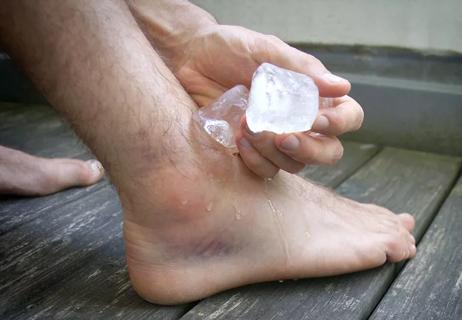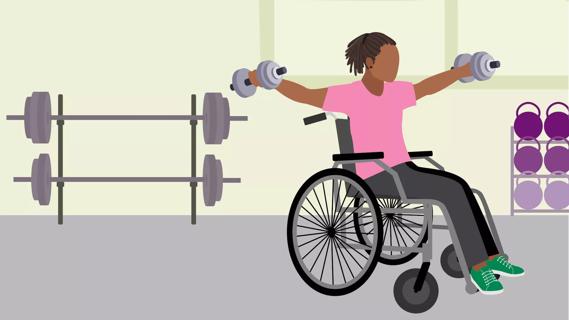An ice bath can ease sore muscles and decrease inflammation after a workout

Have you ever watched behind-the-scenes clips of your favorite sport and seen athletes lowering themselves into big tubs of frigid water after a big game? That’s called a cold plunge, also known as cold therapy or cold water immersion — and it’s basically the practice of taking an ice bath after physical activity.
Advertisement
Cleveland Clinic is a non-profit academic medical center. Advertising on our site helps support our mission. We do not endorse non-Cleveland Clinic products or services. Policy
Sports medicine physician Dominic King, DO, explains how to safely take an ice bath and what benefits it can provide your body after a big workout.
A cold plunge is exactly what it sounds like: A brief dip into an ice bath. And an ice bath is exactly what it sounds like: A very, very cold bath.
But unlike the long, relaxing baths you take for self-care purposes, cold plunges are quick, therapeutic dips in ice water. Brrr!
“You can create an ice bath by filling a bathtub halfway with cold water and then adding three large bags of commercial ice,” Dr. King says. “Or use a smaller container to focus on a smaller part of the body, such as the elbow.” Collapsible cold plunge tubs are sold online, as well.
Fill your bath with water that is no colder than about 53 degrees Fahrenheit (11.6 degrees Celsius). But if you’re new to ice baths, Dr. King recommends starting much warmer, at about 68 F (20 C). Don’t be fooled, though — that’s still pretty darn cold for a bath!
As long as you’re in good health and don’t have any underlying conditions mentioned below, cold plunges may bring some relief to your sore muscles.
“There’s no doubt that some people get great relief from using ice baths,” Dr. King notes. “Patients can get physical, mental and functional benefits from this kind of cold therapy.”
Advertisement
A small 2017 study showed that ice baths may not be as beneficial as once thought, but many medical professionals — especially those who work with serious athletes — still consider them useful. And a 2021 study of college soccer players showed that cold water immersion therapy promotes basic post-sport recovery.
Benefits include:
This one is pretty simple: After a hard workout, ice baths feel good. The cold water constricts your blood vessels, which slows blood flow and relieves some of that swelling and soreness you feel in your muscles after a long run or a hard-fought game.
Again, though, be sure you’re only easing post-workout aches and not actual pain. If you have to push through pain during exercise, there may be an underlying injury. Don’t cover up that pain with cold. “You may be delaying appropriate healing,” Dr. King warns.
If you’ve just worked yourself into a sweat, it follows that an icy dip is a quick way to cool down. When your body is all fired up from a workout, that cold water brings your core temperature back down in a flash.
But be careful: Staying in an ice bath too long can lower your core body temp too much, which is also risky.
“In sports medicine, ice baths are used for marathon runners and others who are experiencing heat injuries,” Dr. King explains. “We use it as an emergency treatment in the field to bring down their core temperature.”
Honestly, you may just like a cold plunge now and then, especially if you find that the jolt of cold helps snap your brain into focus. “Some people feel that it’s a very helpful mental meditation for them,” Dr. King says.
This benefit is mostly anecdotal and not well-proven by research, but Dr. King says he’s heard it from some people.
“Some people say it helps them sleep much better and that they feel less fatigue overall,” he reports.
Cold water constricts your blood vessels, which can help with the swelling related to inflammation.
“Some patients who have swelling and inflammation find great relief from soaking in an ice bath,” Dr. King says.
He notes, though, that other people find that heat works better at reducing their inflammation — so it’s really a matter of figuring out what feels best for your body.
How long should you spend in a cold plunge tub?
It’s best to keep it quick, starting with five minutes and maxing out at 10.
“Start low and go slow,” Dr. King advises. “Don’t go too cold and don’t go for more than five minutes, just to make sure you can tolerate it.”
Studies show that after a few minutes, an ice bath doesn’t do much for you anyway.
“There is some research that shows that after two to three minutes, additional benefits taper off,” he adds.
Advertisement
Before you take an ice bath, it’s important to know whether it’s safe for you. Check with your doctor beforehand, as cold plunges can have negative and potentially dangerous effects on people who have medical conditions like:
Your healthcare provider can also help assess whether you’re dealing with an underlying condition. While ice baths can ease your aches and pains, they aren’t the right choice if you’re dealing with something more pressing, like a fracture, a tendon or ligament tear, or another injury.
“You have to make sure there’s no underlying problem that you’re icing through,” Dr. King emphasizes. “You don’t want to use cold therapy to simply numb pain coming from a more serious injury, like a fractured bone or torn tendon.”
Advertisement
Learn more about our editorial process.
Advertisement

What's best for your aches and pains?

Plus, how long to ice an injury and other icing tips

Calorie reduction can do more than just help you lose weight — it can also lower age-related inflammation

Break up with your snooze button by shifting your bedtime and establishing a consistent nighttime routine

EVOO is full of antioxidants and has anti-inflammatory properties, both of which aid your body in multiple ways

Resolve to move a little more, drink a little less, eat a little healthier, sleep a little better and destress a lot

Head to bed in a bra to reduce breast pain, nipple irritation and stretch marks

Winding down before bed is key to better sleep

Type 2 diabetes isn’t inevitable with these dietary changes

Applying a hot or cold compress can help with pain